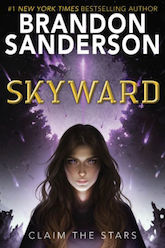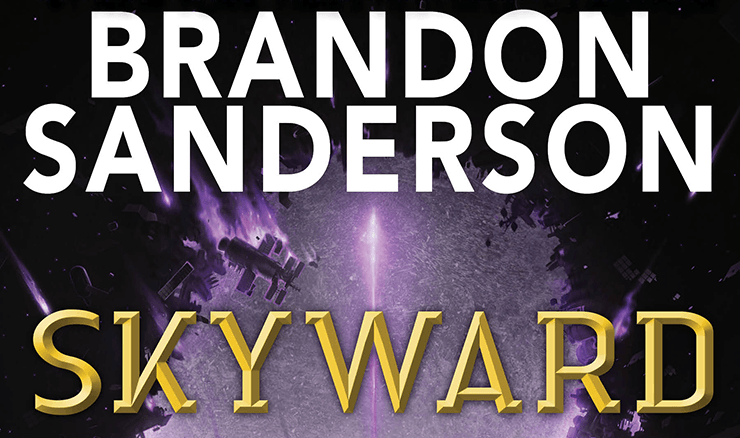Flying onto shelves on November 6th is Brandon Sanderson’s Skyward: book one of his newest young adult series. Our hero is Spensa, a girl who has dreamed her whole life of being a pilot like her father. More than anything, she wants to prove herself brave and strong, and do her part to defend what’s left of the human race. When she was young, however, her father mysteriously deserted his team—leaving Spensa labelled as the daughter of a coward, with her chances of attending flight school uncertain.
Checking in from Beta Flight to provide a non-spoiler review and discussion are Darci Cole, callsign: Blue, and Deana Whitney, callsign: Braid.
We will not touch on the pre-released Skyward material, so if you are waiting for the whole book to be out, this is a safe place and we salute you. A few comments about Sanderson’s other YA series, The Reckoners, are included, so consider yourself warned!
Sanderson has loved the idea of a “boy and his dragon” story for years, yet felt he didn’t have anything new to say in the trope. Eventually, though, he was inspired to mash up the concept with a flight school saga like Top Gun and Ender’s Game. Finally the ideas clicked and he ran with it, making Skyward into a “girl and her starship” story. We both feel he has added more to the narrative than a simple gender flip, however: while Spensa encounters a number of hiccups along her journey, from external and internal forces, every experience drives her and the plot to stunning moments that had us laughing, crying, and cheering out loud.
Some readers may remember that Skyward was originally announced as a Cosmere young adult book, but it is no longer set in that universe. While writing the book, certain plot elements compelled Sanderson to move the story outside of the Cosmere and into another reality from his collection. No, we’re not going to tell you which one—but we will reveal it in the upcoming spoiler review. As for a young adult Cosmere story, Sanderson has said that we will get one eventually…but not in the next two years, at minimum.
In U.S. markets, Skyward is being advertised as a Young Adult series, while the U.K. publisher is marketing it as adult fiction. Sanderson’s ability to appeal to a wide audience range has always been evident, and Skyward is no exception. His characters are fully developed, each with their own dreams, goals, and weaknesses, no matter what age they are. The adults and the teens we meet in this story read as real, multidimensional people. While adults in YA books can occasionally feel weak or trivial, in Sanderson’s worlds they are vital. Just like in real life. And just like in real life, you find people to hate and love.
Buy the Book


Skyward
The flight junkies among Sanderson’s fans will be happy to know he consulted with several real-life fighter pilots to improve the accuracy of describing both the physical and emotional impact of high-speed flying. We can’t say whether he got everything 100% right, since the technology in the narrative is quite different from Earth’s, but the experts were pleased with the final results. Here, Sanderson’s established skill at building strong magic systems translates into building a technology system that feels believable and follows his Laws of Magic. (Including the occasional use of “the rule of awesome.”)
Readers will enjoy his hallmark cinematic writing style, with plenty of strong visuals throughout the story, along with humor that some will love, and others will love to hate. (Braid: Like David’s metaphors.) The story races to an exciting conclusion once the famous Sanderson Avalanche starts. (Blue: You mean Sanderlanche.)
When that point in the story hit, none of the beta readers could put the book down until it was over…there were some very late nights.
Now to break down some of the finer themes of the book—at least, the ones that we can discuss for now, without spoiling anything!
Friendships
Braid: Let’s first address a recurring criticism of Sanderson’s work: the lack of female-female friendships. Especially for his younger characters like Vin, Megan, and Shallan. Not many girls they can talk to in their respective stories.
Blue: It’s true. Sanderson has made a great effort to develop amazing female characters, but hasn’t given them many female friends to interact with in the past. In Skyward, however, I thought he nailed it. As a woman who only had a few close female friends as a teen, these budding relationships rang very true to me.
Braid: They read as real to me as well. It delighted me to see the characters interacting on the pages. Among Spensa’s friends, I have a new favorite supporting character.
Blue: I think I can guess who that is, and she’s one of my favorites too. But as the Saint would say, “Don’t spoil your eggs before they crack.” The other thing I loved is that we get to see these friendships build in such natural ways. And who knows, we may just see some of those relationships grow into more in future books—but not in this one. *wink*
Worldbuilding
Blue: One of my favorite things about Sanderson’s stories is his ability to give us new worlds that are built to make sense. Spensa’s world will be somewhat familiar to us earthly readers, but it’s the small detailed differences that really make it stand out. The history, the culture, the geography—everything was pieced together so perfectly.
Braid: I’m not sure about perfect. There are some elements of this culture that I hope to see die in flames before we reach the end of the series. However, the current culture does seem to fit the hardships of their reality. It also has a high level of cohesiveness to itself, which I appreciate for being logical.
I hate when the premise of the worldbuilding is flawed from the start. I enjoy that it’s not set on Earth. Yet, Earth and its history did exist in this universe. The planet is very different, without going to the extreme of Roshar, where The Stormlight Archive is set.
Blue: I completely agree with you on the “die in flames” elements. Those bits of the culture leave room for us to see them change and shift (fingers crossed). There were some frustrating moments, but for me it all read true to the world Sanderson has built. Lastly, trying to be as vague as I can, but I will say that the creatures in this particular world were one of my favorite things about it. I’m excited to see more of them.
Braid: Oh indeed. The back of the book mentions an “accidental discovery.” I think readers will delight in the results of this discovery.
The Outsider
Braid: Sanderson has stated that Ender’s Game and How to Train Your Dragon were major inspirations points for Skyward. One thing these stories have in common is an outsider main character. Spensa embodies this element well. Ender and Hiccup do not fit inside their societies, either. I’m unsure how well she would get along with either guy, but the three do share a spirit of independence. Honestly, I’m cool with this. I welcome the outsiders and rebels.
Blue: This is such an interesting concept to me, and there are a few ways I’ve seen it done. One way is to write a character who sees their world differently from the rest of the characters, but that’s not what Skyward does. When we meet Spensa, she’s an outsider because of something that wasn’t her fault, and she wants more than anything to be accepted into the ranks she’s been shunned from for so long. Just like Hiccup in HTTYD.
Braid: True, she’s fighting to be a pilot, like her father. Who they now call a traitor and a coward. Yet he’s a hero in her eyes. She fights inside the system, against the system. A hard lot for a 17-year-old to draw; it might make you want to punch someone. I’m glad Spensa develops those friendships with the other odd ducks to help navigate her course.
Blue: Absolutely. Multiple characters in Skyward experience their own journeys of change and discovery. What hit my heart the hardest was how they all managed to grow and learn in their own ways, yet their paths were built so well to fit together. It makes the occasional frustrating bits worth it in the end.
All in all, we say Skyward is an adventure and a half that you won’t want to miss. Even hardcore Cosmere fans will enjoy the special mix of fantasy and sci-fi that unfolds as you watch Spensa learn what it means to be truly brave.
That’s it for now. We’ll be back with a spoiler review once the book is officially out November 6th—until then, enjoy flying Skyward everyone!
Skyward arrives November 6th from Delacorte Press.
Darci Cole—Callsign: Blue—is an aspiring author of young adult and middle-grade fantasy, audiobook narrator, Harry Potter Superfan, and Sanderson Beta Reader. You’ll recognize her by the blue streak in her hair, and can find her on Facebook, Twitter, Tumblr, and Instagram as darcicoleauthor. Spensa’s spaceship is her Patronus.
Deana Whitney—Callsign: Braid—is a Sanderson Beta reader, a historian, a cook, and avid reader. Known as Braid_Tug on Tor, she is working on another Cosmere Food article. She may have re-listened to the Top Gun soundtrack a few too many times while reading this book.










